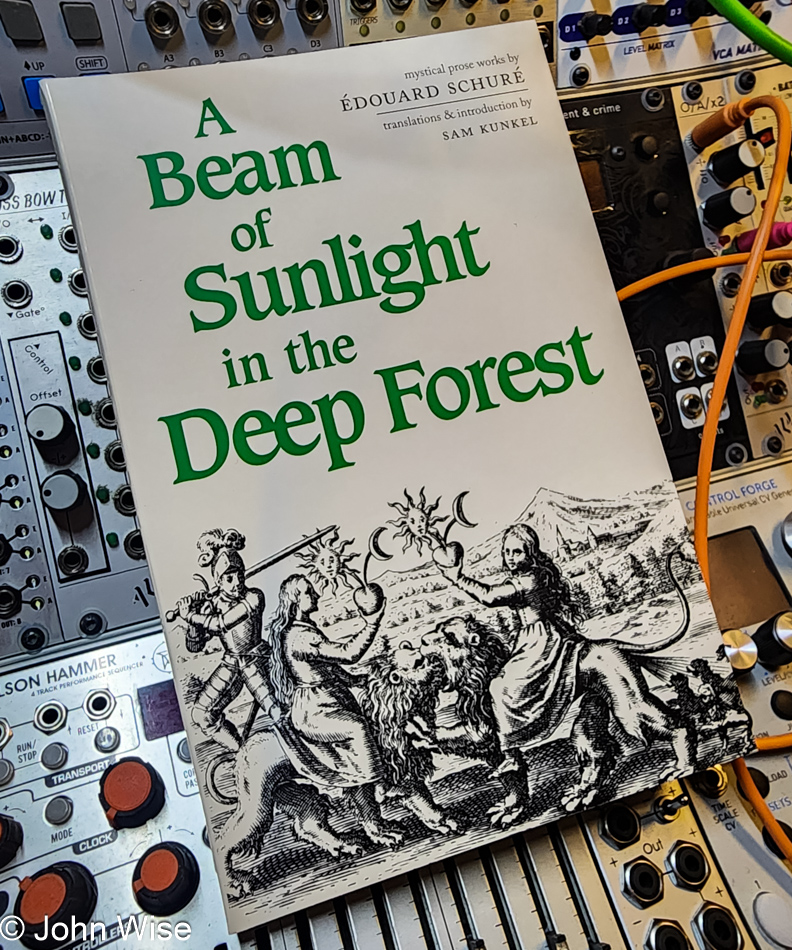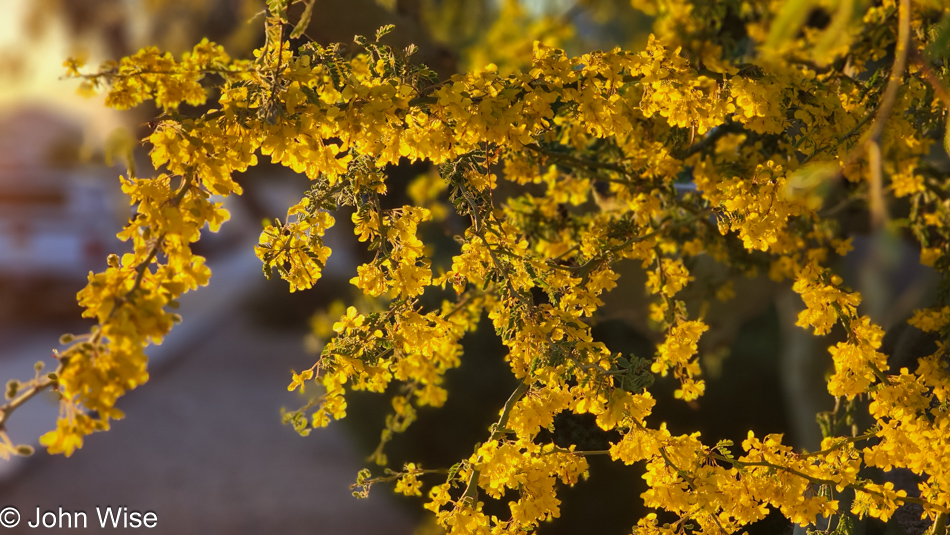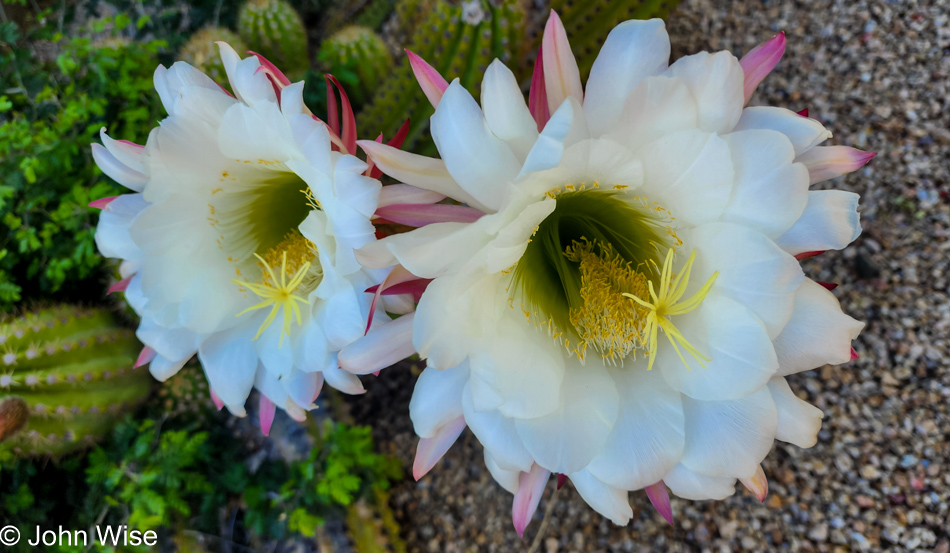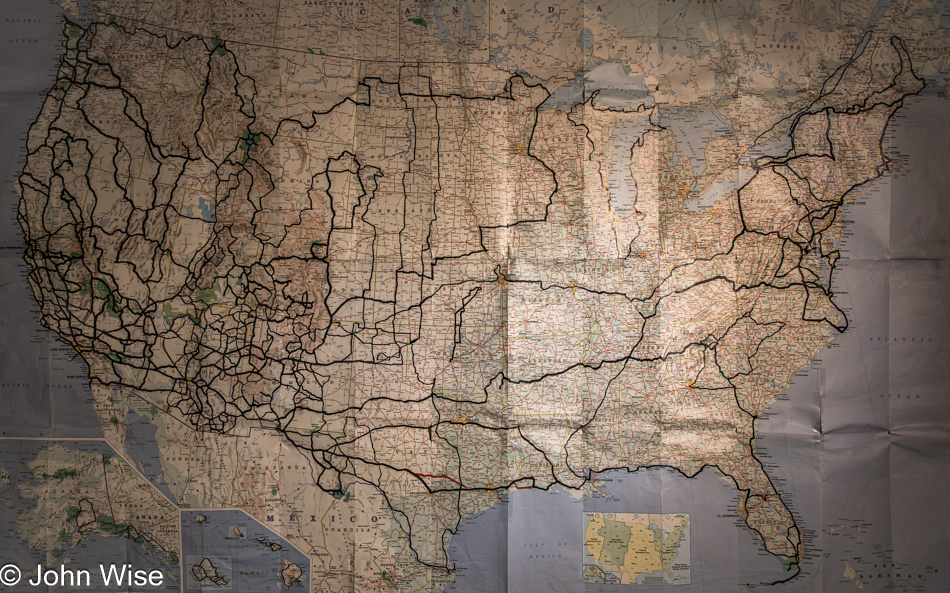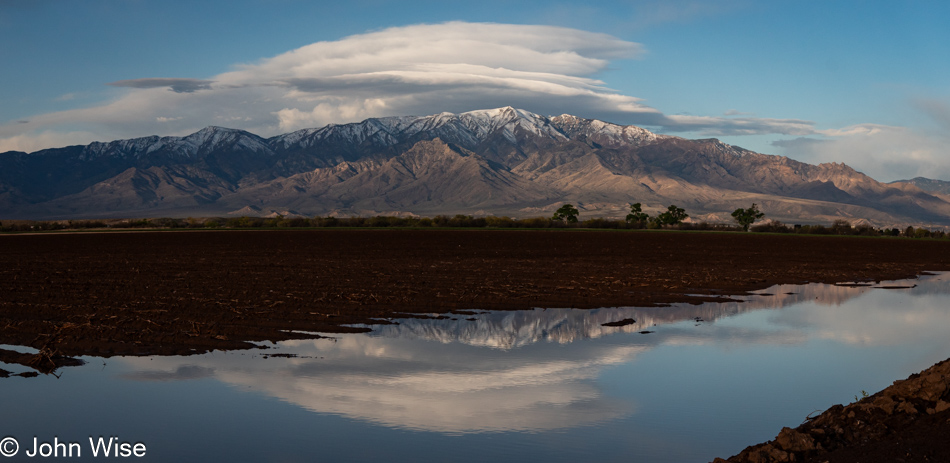
Well before dawn, we left our motel and stopped at a gas station for a coffee, as that’s what there was for coffee in Ozona, Texas. This, though, was a fortuitous moment as we found a lucky penny we would come to be certain changed our day. The idea behind our early departure was to beat the horde we were sure would trek south into the Del Rio, Brackettville, and Uvalde areas. Well, here we are on our way south, and the horde has not materialized. Maybe the poor weather forecast kiboshed the plans of some of those 42 million people who were expected to venture out for this full eclipse that is the last one visible over the U.S. for the next 26 years.

A couple of hours later, we arrived at a coffee shop in Del Rio, Texas, less than five miles from Ciudad Acuña, Mexico, and about two hours from the start of the solar eclipse. We’ve driven 887 miles (1,427km) across the deserts of Arizona, New Mexico, and Texas to be here only to arrive under a seriously overcast sky with weather reports warning of severe storms in the area later today. Obviously, the sky in the photo here is not overcast, it was taken while still driving south to Del Rio.
With nothing else to do, we took up a perch at a table, with me busy playing the roles of both cantankerous Muppets Waldorf and Statler. Per my normal mode of operation, I’m grading my fellow human beings. Exactly how well they fit into that narrow definition regarding human characteristics is up for debate. First point of observation: the women here have not mastered the art of skin-tight booty shorts/leggings: you should either rock them commando-style or wear a thong because lechers such as myself do not want to see your panty lines digging deep into the girths you are shoving into your second skin. Next point, desert-sand-tan leather boots of one sort or other appear to be de rigueur for Texans unless you are a visitor from Florida, in which case you wear sandals. Californians appear to prefer running shoes.
There is certainly a nice diversity out here in West Texas and not a single person practicing their right to open-carry a weapon. Speaking of weapons, I’d briefly considered a side trip to Uvalde for some morbid tourism, but with nearly 900 miles ahead of us as soon as the totality passes, we’ll need to hit speeds approaching 150 miles per hour (240 km/h) if we are to make it back to Phoenix this evening before 9:00. Pardon me, not being in Germany, Google is estimating that we’ll need almost 14 hours to get home, leaving no time to take in a mass shooting site.
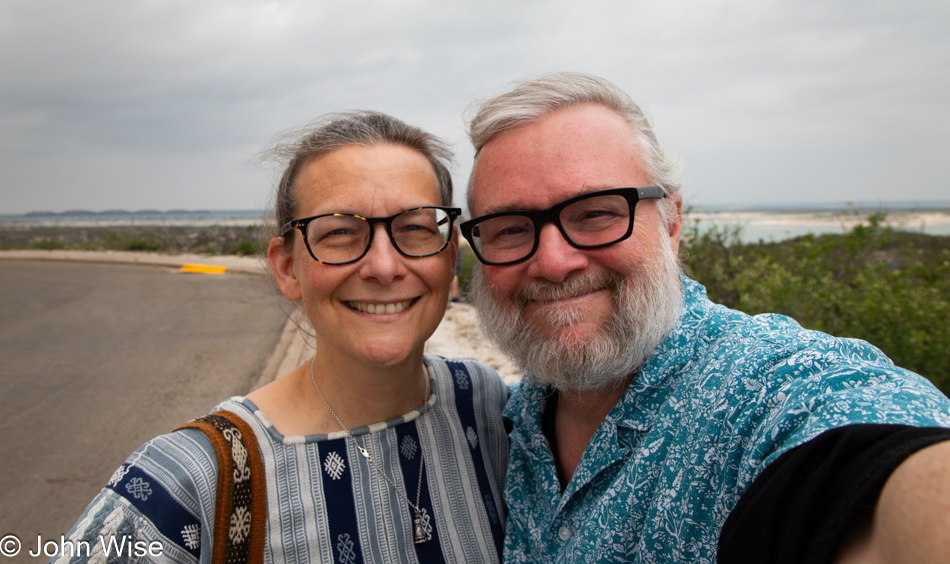
Note the overcast sky behind us here at the Amistad National Recreation Area that was chosen as our viewing spot for the totality because it’s just a little west of Del Rio and significantly further west of Bracketville, our original destination. The weather forecast showed that there was going to be some breaking up of the storm clouds starting in the west, and as long we were still in the path of the totality, we figured it was better to be happy with a little more than two minutes of the full eclipse rather than risk seeing none of it. As for the selfie, I was supposed to share one of us during the eclipse, in the dark, but it turned out that having been rendered into blubbering crying babies by the sun in eclipse, or was it the shadow of the moon, that teary-eyed image I shot is not fit for posting here if I want to maintain my illusion of manhood.

How lucky was our misfortune of having our destination shift at the last minute? By coming to the Diablo East section of the Amistad Reservoir, the park service was on hand to inform the public and help them see the eclipse, but it was this special Eclipse Explorer Junior Ranger badge that made everything worth it. Even had we never seen the sun itself, just adding such a rare badge to the collection would have meant the world to Caroline.

It was about 12:15, when we noticed the moon starting to creep over the sun for the first time. The clouds were streaming overhead, and while this might look bleak, the photos I took with my DSLR without any filtering were turning out better with some cloud cover than those with clearer skies. Because I left Arizona with the idea that taking photos of the eclipse was the thing I was least interested in, I had not brought my 70-200mm lens, ND filter, and tripod so I could better focus on the matter at hand rather than witnessing it through my camera.

With more than an hour between the start of the eclipse and totality, I had plenty of time to get a shot here and there, many shots actually, though most have ended up in the digital dustbin of history, never to be seen again. By this time, the excitement from the adjoining parking area, where the majority of star chasers were positioned, was palpable, with cheers going up every few minutes as the moon crept closer to blotting out the light of the giant hot disk in the sky.
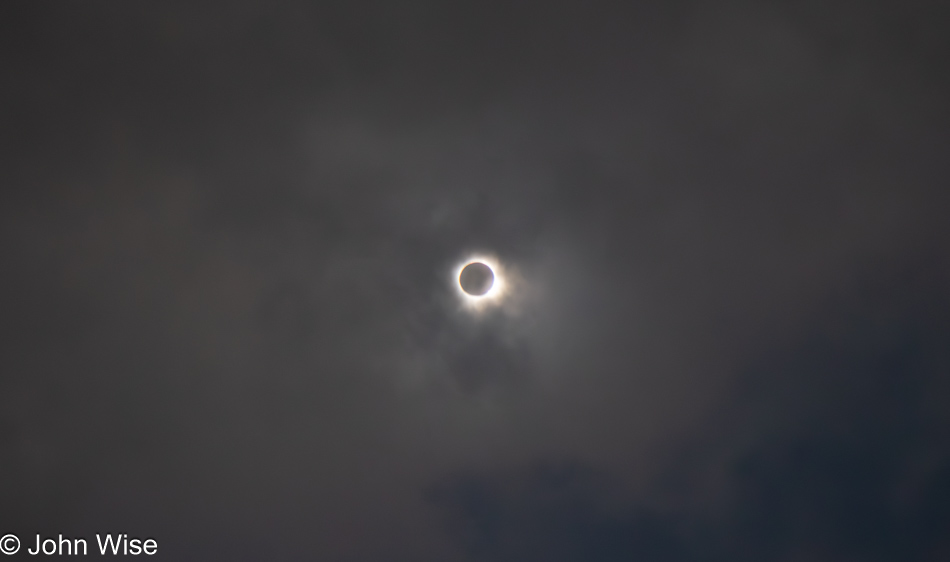
Something unexpected happened on the way to falling under the full shadow of the moon, known as the totality; as the moon moved into position, the gravitational disturbance of some deep-seated primordial senses lingering in our bones punched the two of us, doubling us over in a stream of tears. Nothing bad, mind you; it wasn’t that we were seeing God and the second coming of his son ignoring our presence as if to notify us that we’d be dwelling in hell, nope, nothing like that. We were seriously overwhelmed by the incomprehensible beauty of watching the living prominence of the sun pulse and breathe in a manner never previously witnessed by either of us.
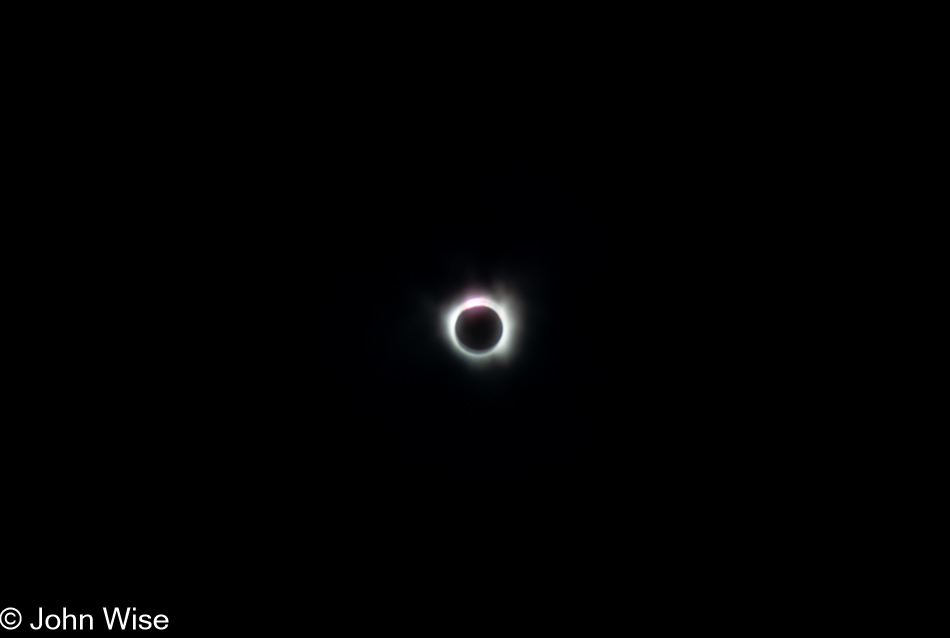
Not having been prepared for the gargantuan emotional outpouring that seized us, all of a sudden, I was gripped by the wish to have the most exquisite record of this event so I might better reference the images and always remember where the universe took me today. As desperately as I desired a perfect artifact of this solar phenomenon, my senses never stopped telling me to focus on looking at the totality as I will likely never have the opportunity again to stare at the sun without filtered glasses and not damage my eyesight or go blind.
While staring at this incredible sight, one has to remember to also look around as it truly became dark all around us, so dark in fact that the lights of the parking lot had turned on. The orange glow on the horizon was also a sight to see, and while I tried taking photos of that beautiful view, the settings on my camera were set for taking pictures of the sun, and I couldn’t figure out how to change anything while enraptured in the state of weeping ecstasy I was gripped by. Take note, I wasn’t alone in this emotional outpouring; maybe we were even triggering each other to cry harder as we felt the others’ empathy and understanding of such a momentous event.
There were two moments of feeling that it couldn’t get any better: the first was at the beginning, when a seriously heavy amount of clouds moved in to block all sight of the eclipse and we thought we’d seen all of the totality we’d be afforded. Satisfied, we started looking around again at the general area until a roar went up from the large group that drew our attention back to the sun. The impenetrable cloud cover must have exploded because the sky was as clear as anyone could have dreamed of, we saw stars in the distance in the middle of the day.
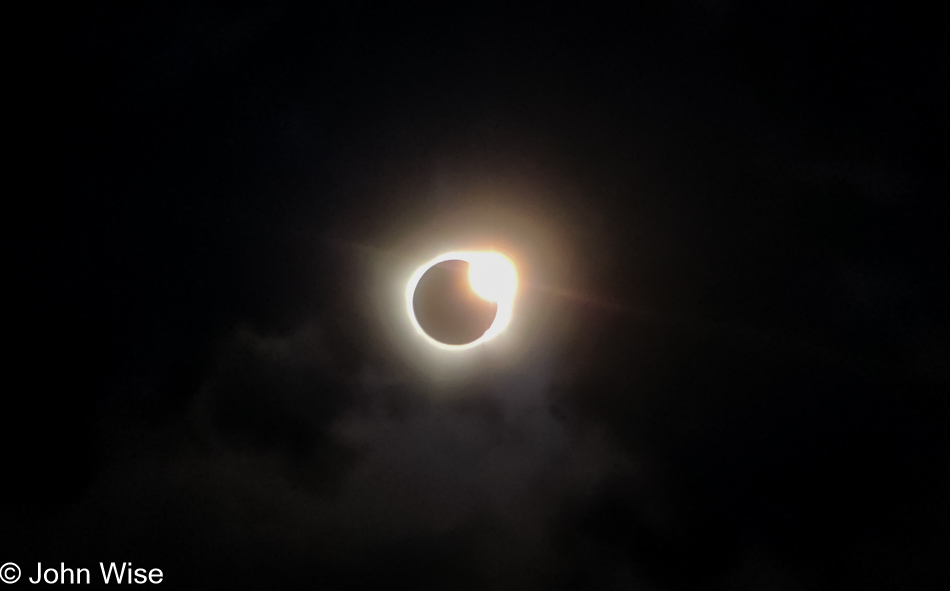
The next moment of ultimate wow was the fabled diamond ring which I only barely captured here with my phone. This image does zero justice to what was seen with the naked eye. At this point, there was a kind of threat of madness that should we stare any longer into the absolutely ecstatic image of what was playing out in the sky, we’d simply have to dissolve from the intensity of it all. To say we were shaken would be an understatement. Never before in all of our travels, both geographically and psychedelically influenced, have either of us been taken to such an emotionally giddy place of euphoria. A week later, while writing these words, I can still feel the sting of my eyes as I recollect the fervor of sensations coursing through my heart and mind, struggling to make sense of such a rarity of experience.

For 3 minutes and 28 seconds, Caroline and I were lost under the eclipse, hardly able to think, reduced to nothing but feeling. We left the area about 10 minutes after the totality with tears still threatening to spill from eyes full of the immensity of that incomprehensible beauty, and for the next 45 minutes driving up the road, the knot in our throat remained ever-present. In hindsight, it could have only worked out this fortunately because of that lucky penny found at the start of our day. As for the rest of the day, nothing else mattered.

